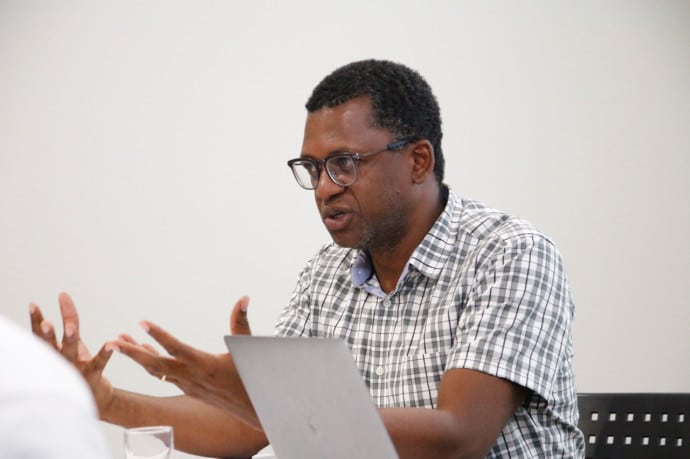“Focusing on the differences between cities in the Global North and South, and the concept of Southern Urbanism is central to many bodies of literature. Theories have emphasised the differences – mostly the primitive in relation to the civilised. I think we need new ways to engage with cities in the Global South. I’d like to flip that idea to also see the similarities,” said António Tomás of the African Centre for Cities at the University of Cape Town. Tomás is a STIAS fellow and is working on a book titled In the skin of the city: Luanda or the dialectics of Spatial transformation which will be published by Duke University Press. The book will focus on Luanda and Paris.

“I have some problems with the concept of Southern Urbanism,” he said. “The book is a response to that. I will be disagreeing with a number of urbanists who tend to explain African cities as alien urban experiences. By comparing Luanda to Paris my intention is to come to terms with ways of describing that focus on sameness rather than difference. What makes Luanda an interesting case is that it was formed by the same processes, forces and drivers that were also in play (on different scales, of course) in the formation of places such as Rio de Janeiro or Paris. The fact that Luanda is neither Rio de Janeiro nor Paris is precisely because of the ways in which the dialectics between imagination and potentiality, desire and implementation, technique and politics, and so on, have played out there.”
“Yes, Luanda is unique in that it is different from any other place,” he added, “but I don’t want to focus only on the aspects that are unique.”
The book will examine the process of historic formation and transformation of Luanda, the capital city of Angola. Luanda was one of the first African cities settled by Europeans in 1575 and the development of the city has been profoundly affected by historical events. Among these, Tomás highlighted the Portuguese and Dutch occupations; the slave trade; the development of the port and city as a strategic hub and a new modernist city in the 1950s and 60s when many of the old buildings were replaced; and, the 1975 revolution leading to Angolan independence.
“The slave trade, for example, created the conditions for the emergence of a vibrant creole culture in Luanda. The abolition of slavery in the early nineteenth century then led to increasing compartmentalisation of the population due to the perceived danger of allowing the black population too much power.”
“Independence in 1975 meant that some 500 000 people left the country and the government actively encouraged the population on the outskirts of the city to come into the city centre – bringing different practices and experiences to the city.”
“I explore the nature of these transformations,” said Tomás. “This book is an ethnographic description of how Luanda has come about, how its inhabitants have transformed it from a colonial into a postcolonial city, their lived experiences and how they have reflected upon this transformation.”
“This project stems from my understanding that the best way to expand our knowledge of the dynamic of postcolonial cities is not by debunking Western urban theories (which are aimed at universalising the urban experience), but by provincialising them. I do this by using Luanda as raw material for ethnographic theorisations, through the description of the myriad ways people’s actions reconfigure the city. Exploring cities as an archive may provide adequate tools to understand them in their own terms.”
And why the comparison with Paris?
Tomás described both practical and theoretical reasons.
“On the physical side – much of the architecture of Luanda was inspired by French architectural traditions and reminds you of Paris. But, more importantly, Paris is a product of a particular imagination and specific historical events – so is Luanda. It’s about how politicians, architects and engineers through time have imagined a particular space for various purposes – whether business, tourism, etc.”
Walking the city
He described how he starts his fieldwork literally by walking the city. “I walk in every new city I go to. It allows me to engage with the city and the people,” he said. “In many places in Luanda sidewalks are non-existent, hard to walk on because of their bad condition but also because of hawkers and people living there. By contrast there are areas with nice sidewalks where no one walks. In Paris, on the other hand, the sidewalks are continuous, specifically maintained for walking, and there is a long tradition of walking the city.”
It’s also about understanding the different reasons why people walk – walking for exercise, relaxation, tourism versus walking for work opportunities and employment because there are no other transport options. “There’s a difference in scale between Luanda and Paris – there is poverty and unemployment in the Global North but not on the same scale as the Global South and this affects the city development.”
“I’m interested in how people engage with the space. How they walk differently on different sidewalks. How they inhabit the buildings.”
“It’s about getting under the skin of the city – the skin that separates the inside from the outside but is also scarred by experiences,” he continued. “Colonialism, the slave trade, expansion and consolidation – these are all about distinguishing between the inside and outside.”
“I’m interested in the ways in which cities are transformed and described through lived experience, and both imagined and concrete realities.”
Michelle Galloway: Part-time media officer at STIAS
Photograph: Christoff Pauw
